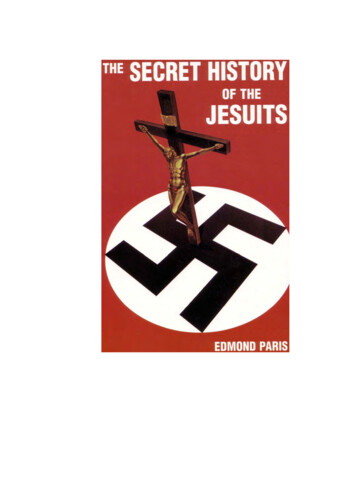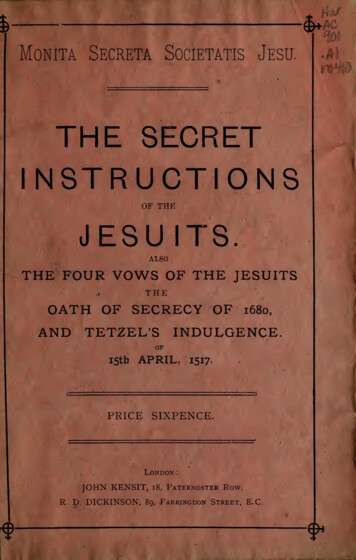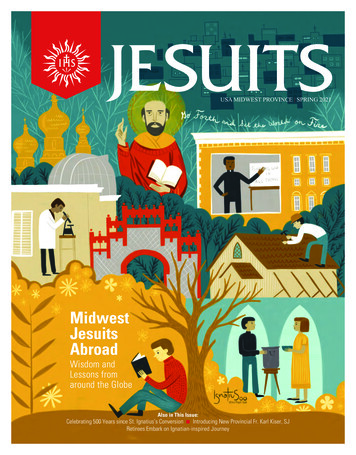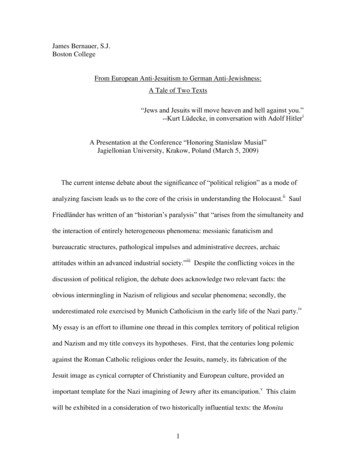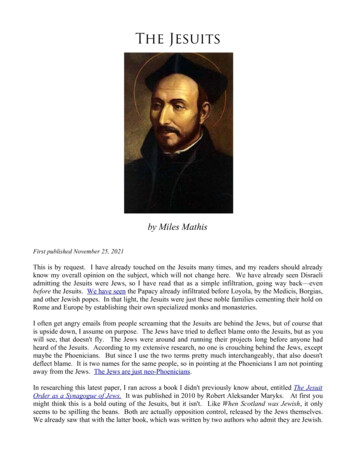
Transcription
The Jesuitsby Miles MathisFirst published November 25, 2021This is by request. I have already touched on the Jesuits many times, and my readers should alreadyknow my overall opinion on the subject, which will not change here. We have already seen Disraeliadmitting the Jesuits were Jews, so I have read that as a simple infiltration, going way back—evenbefore the Jesuits. We have seen the Papacy already infiltrated before Loyola, by the Medicis, Borgias,and other Jewish popes. In that light, the Jesuits were just these noble families cementing their hold onRome and Europe by establishing their own specialized monks and monasteries.I often get angry emails from people screaming that the Jesuits are behind the Jews, but of course thatis upside down, I assume on purpose. The Jews have tried to deflect blame onto the Jesuits, but as youwill see, that doesn't fly. The Jews were around and running their projects long before anyone hadheard of the Jesuits. According to my extensive research, no one is crouching behind the Jews, exceptmaybe the Phoenicians. But since I use the two terms pretty much interchangeably, that also doesn'tdeflect blame. It is two names for the same people, so in pointing at the Phoenicians I am not pointingaway from the Jews. The Jews are just neo-Phoenicians.In researching this latest paper, I ran across a book I didn't previously know about, entitled The JesuitOrder as a Synagogue of Jews. It was published in 2010 by Robert Aleksander Maryks. At first youmight think this is a bold outing of the Jesuits, but it isn't. Like When Scotland was Jewish, it onlyseems to be spilling the beans. Both are actually opposition control, released by the Jews themselves.We already saw that with the latter book, which was written by two authors who admit they are Jewish.
And it is the same with Robert Maryks. Did he fool you with that name? Try spelling it Marx.Maryks is an assistant professor at Boston College, so you can be sure he isn't doing anythingrevolutionary here. If he did any real research they would fire him immediately. The book waspublished under the auspices of The Studies in Medieval and Reformation Traditions, which appears tobe founded, edited, and overseen by Jews. Maryks actually thanks a Borja in his acknowledgments.We see what they are up to very fast in the long introduction, where they admit what is already known:the first Jesuits, including Loyola, were conversos or crypto-Jews, from noble and wealthy families.But then Maryks tries to convince us that although it was OK to be a Jesuit Jew from 1540 to 1593,after 1593 (see p. 117) the Jesuits were cleansed of Jewish blood from within, by new rules forbiddingit. That isn't believable on the face of it, so we should look closely at Maryks' evidence. Does he proveit or even indicate it? No, he just says it.But let's back up. In order to build street cred in the run up to that argument, Maryks admits the firstJesuits were Jews. Disraeli and many others, including other prominent Jews and rabbis, have alreadyadmitted it, so Maryks isn't telling us anything we don't already know. But as part of building his cred,he does go into a bit more deeply than others before him, showing a lot of evidence they were Jewish.So this should interest us, and does. It probably explains why the book—although prepared ascontrolled opposition by the Jews themselves—was soon pulled from the shelves. It is almostimpossible to buy, being out of print and going for hundreds of dollars online.My link above goes to Veteran's Today from 2018, where Gordon Duff is recommending the book.Also for street cred, I assume. And also to sell you the idea the Jesuits were only Jews before 1593.
So let's look at the first Jesuits. The first one I will look at is very easy, that being Alfonso Salmeron.You can tell he is Jewish just from the name. Salermon Salmon Salomon Solomon. Also see hispicture, which is easy to read. A preternaturally long hook nose and no cross around his neck. But ifthat kind of evidence offends you, I send you to Maryks, who gives you much more. Salmeron wasfrom Toledo, where his family were known Jews of longstanding and huge wealth. If you search forhim in Maryks' book online, good luck. The important things don't come up either on an internalsearch (cntl F) or in the index. So I will just give you the hint: go to the footnote of page 55, whereMaryks admits many Jewish historians have admitted Salermon is Jewish, including Friedman, GomezMenor, and Salvador.Toledo had been a Jewish stronghold for many centuries, being run by Phoenicians back to Romantimes. Back then they were known as Carpetians, and by the 1 st century AD Toledo already had thelargest Roman circus in Spain. By the third century it was already a favored town of the wealthiest inthat region, due to its use as a trade and banking center (and being on a pretty hill surrounded byrivers*). We are supposed to believe these people running Toledo in those years were Goths, iewildmen of the north, but there is no evidence of that. Like the Vikings, they have been sold as
something they weren't. Most likely they were northern Phoenicians battling with their southerncousins. If they had been wildmen they couldn't have competed with the Romans. It is admitted thatthe Jews were in Toledo from the beginning, but we are supposed to believe they were oppressed bythe Goths and then the Moors and all along by the Christians. The usual story. The usual flip ofhistory.The truth seeped through in the 7th century under Archbishop Julian of Toledo, supposedly a Goth rulerwho legislated against the Jews. Except that they admit he was Jewish. Amazing, isn't it, that theseJew-hating Goths had a Jewish primate? Although the Goths were sold to us as wildmen, they alsoadmit that Toledo in the 7th century was a center of literacy and writing. Was this writing in the Gothiclanguage, in the Gothic alphabet? No, again as with the Vikings, you are supposed to believe the Gothshad no written language. They were barbarians you know, and just spoke in grunts and waves of theirhands. Once the Romans arrived the Goths borrowed their alphabet and language. So convenient.And here's a strange fact, right from Julian's Wiki page: a lost work of this Julian is said to be on thesubject of Jews owning Christian slaves. That's pretty hard to spin, isn't it? Just think about it: if whatwe are told about Jews being third class citizens were true, with edicts constantly being passed againstthem and so on, how could they ever have Christian slaves? It makes no sense, because slaveownersare never from a repressed class themselves. You would expect the Jews to be slaves in that time andplace, not to own them, so this story makes no sense. Just to be sure you are getting it, I am not sayingJulian didn't write a book on that. I am saying the Jews weren't repressed. They were the upperclassthere, as they always were and still are.This early Spanish Renaissance was presided over by Isidore of Seville, the most scholarly man of histime and the Archbishop of Seville. If you want to know who he really was, they give you clue: he isalways depicted surrounded by bees. See Gerry's papers on the Phoenicians to see what that means.This indicates that his edicts against Jews were the usual smokescreens. Compare it to the more recentstories about Jews being kept out of country clubs in the US up until a few decades ago. A joke, sinceit isn't true. But it allowed the Jews to hide, because if you saw someone at a country club back then,you just assumed they had been vetted and weren't Jewish. They looked like that because they wereSyrian or Lebanese or something, I guess. In the same way, Isidore's edicts against the Jews made itlook like something was being done against usury or venality, when nothing was. Just like now.I pause to point out that on the Wiki page for Toledo, they skip ahead from 1085, when the Castiliansdrove the Moors out, to 1525. That's kind of curious, isn't it? Nothing happened in Toledo for over400 years? Except that they do quickly list the Jewish persecutions of 1368, 1391, 1449, and 1486.Indicating Jewish authors of this page. Why would we get many paragraphs on the late 600s, but not aword on the first real “Spanish” period in Spain? We may hit that another time.But just to give you some idea, Charles V became King of Toledo and Holy Roman Emperor in the1500s, and he was of course a Habsburg. His father was Philip the Handsome, King of Castile:
Gorgeous, ain't he? Here's his father:Note the nose and the red hair. Not what you expected I bet.
Before that, Toledo and most of the rest of the peninsula was ruled by Burgundians/Ivreans, and theycame out of the Carolingians. That is, the Phoenicians by yet another name.Next, as one of the first Jesuits we find Peter Faber. He is supposedly a shepherd who ended up at theCollege Saint-Barbe at the University of Paris, which is sort of like the French equivalent of TrinityCollege, Cambridge. It would be like being told a bootblack ended up at Oxford or that a little blackboy from the slums of Kenya ended up at Harvard. No wait, we were told that, weren't we? I havenews for you: Faber has always been a Jewish name and still is. See for example the new Jeopardyguest host David Faber, admitted to be Jewish. Also see Swiss investor and famous racist Marc Faber.Also alleged Holocaust survivor David Faber. Also slave trader Mary Faber, whose maiden name isconspicuously scrubbed, probably because it's Cohen or something. Strangely, Peter Faber is notmentioned once in Maryks' book. Instead he calls him Pierre Favre, I suppose to keep you fromremembering what I just told you. Best guess is Faber was a wealthy Savoyard hand-picked by theMedicis for this project.Next we have Francis Xavier, real name Francisco de Jasso y Azpilicueta, which indicates he was fromthe Azpilicueta dynasty. Another from this dynasty, Juan Bautista de Orendain y Azpilicueta, 1 stMarquess, was later Prime Minister under Philip V. He has a page at Wiki, but it also doesn't come upon a search for that name. Xavier's father was Privy Counsellor and Finance Minister to King John IIIof Navarre. So in this case they pretty much admit he was Jewish. Finance ministers have always beenJewish, since they are bankers. They also admit his mother, Dona Maria Azpilicueta y Aznarez, was ofNavarrese nobility in both lines. Xavier didn't even study theology, getting a Master of Arts andteaching Aristotle at Beauvais College, Paris. He was recruited last minute to replace Bobadilla, andwent straight from teaching Aristotle at the University of Paris to a meeting with the King of Spain,Charles I. Up to that time, Xavier's favorite book was De Institutione de bene vivendi (the Institutionof living well) by Croatian humanist Marko Marulic. Could you ask for a bigger clue? Marulic'smother was of the Albertis, Italian/Jewish nobles. His most famous poem was called Judita. Do I needto explain that to you?The fake historians tell us Xavier quit his teaching position at University of Paris in 1534 to studytheology, being ordained three years later, but I don't believe it. If so, why was he a last minutealternate for Bobadilla? Can you imagine turning your whole life over for this idiot Loyola, gettingordained, and then not being chosen as one of the first Jesuits? We are supposed to believe that ifBobadilla hadn't gotten sick at the last minute, Xavier would have been lost to history, all due to somepledge in a crypt.As you may know, Xavier was sent to Goa, India, allegedly to set up a mission, but—as with allprominent missionaries since then—he was actually there for business. We may assume he was thereas an agent of the merchants, and his cousins the Jewish bankers, who were already in India but wereanxious to expand at that time. Their financial successes in Europe gave them extra capital to spend inexpanding their empire in the East, so we can read Xavier's trips as early East India Companyexcursions. Remember, this was only 60 years before the official opening of the EIC in England in1600. Drake had already been to the East Indies by 1579, and one of the places he visited was theMoluccas (west of New Guinea). Not coincidentally, Xavier also went there, but thirty years earlier.The Portuguese had already been there for decades, and they had their own East India Company. Doyou really think Xavier was there preaching? They admit that Xavier had always wanted to be animportant society man, so it is pretty difficult to imagine him walking around barefoot in India, tendingto the sick and poor. My guess is he was there sitting on velvet cushions and being fed grapes by halfnaked women.
Which reminds us that Goa is also a strange place to be doing missionary work. It has always been therichest area of India, though they tell you that is now due to tourism. You have to laugh. It has alwaysbeen due to mining. The Portuguese didn't capture it in 1510 for tourism, or for coconuts either. Theyhave been mining iron and gold from the beginning, though there is no mention of gold mining on theWiki page for Goa. However, if you do a search on it, many current active gold mines come up. Weare told Xavier built St. Stephen's Cathedral in Kombutherai in 1542, and they give you a bad pictureof it on Wikipedia. But if you look it up, this comes up:Does that look like it was built in 1542? It looks like a Hollywood quick-build to me. The interior maybe even worse:
Where did they get those decorations, Dollar Tree?I love the plastic lawn chairs St. Xavier built in 1542. As I often say, they really think we are stupid.
I will be told the church was recently rebuilt. Obviously. But why don't we have pictures of theoriginal church? Or the ruins? No one had cameras there until after 2010? No artists ever painted ordrew the old famous church of St. Xavier or its ruins? The very wealthy Roman Catholic Church hadno desire to keep this site up as a holy site, due to its historical significance? We are told the Jesuitsabandoned the cathedral soon after they built it. My guess is they abandoned it even before they builtit: meaning, they didn't build it at all. Xavier is supposed to have built 40 churches in India in just threeyears. With just one hammer, his own strong arms, and the light of the Lord, I guess. But that isn'thow the Catholic church worked back then. When they built cathedrals they did it right. They didn'tjust throw up a wooden frame like the Amish. They built with stone and took years to do it. And theycertainly wouldn't build a church and then immediately abandon it.See for example the Cathedral at Chennai, first built in 1523 and visited by Xavier. It is now a hugeawful Neo-Gothic basilica, but the original church existed until 1892, and we have pictures of it.OK, let's move on to Diego Lainez, whom everyone admits was Jewish. Everyone but Wikipedia, ofcourse, which skips over his family and early years.Amazingly, Maryks admits (p. xxvi) that during the converso controversy of the Third GeneralCongregation, those involved used the word “Spanish” to mean “Jew/converso”. The anti-Jewishfaction was referred to as anti-Spanish. Wow. That tells you how prominent the Jews were in Spain atthat time, though Maryks runs right over it without comment. Lainez was a close friend of Salmeron
from childhood, they having grown up in the same Jewish neighborhood. Maryks admits on p. 57 thatmany of Lainez' family had been sentenced for Judaizing. He also admits that Jeronimo Nadal liedabout this, claiming the Lainez were “exemplary Christians”. The Italian Jesuit Benedetto Palmiostated for the record that Lainez had admitted to being Jewish. Sacchini admits Lainez' Jewishness inhis famous biography, and Maryks puts it this way in a footnote on p. 59:Modern scholarship has established Laínez’s Jewish genealogy, which had been already beenknown to his contemporaries.Maryks doesn't even bother trying to reprove it, taking it as already proven beyond any doubt. SinceLainez was the second Superior General of the Jesuits, that pretty much settles the question.Now, what about Ignatius Loyola himself? See his portrait under title, which settles the question in myeyes. But, again, if you are offended by that sort of evidence, read Maryks or many other historians,who admit Loyola was surrounded by Jews from the beginning, socializing with almost no one whowasn't Jewish during his career. Then we have this on p. 50:Kevin Ingram has hypothesized in his recent Ph.D. dissertation the converso origins of Íñigo’smaternal grandfather, Dr. Martín García de Licona, who “was not just a merchant, [but] aman of letters and a f nancial advisor at court—that is to say his profle is very much that of aconverso merchant professional.” Consequently, Íñigo too would be considered a converso.Somehow Maryks, like many others, manages to dismiss these piles of evidence as inconclusive. Butthere is another clue all of them have missed.That is the coat of arms of the Onaz y Loyola family, which was then used by the Jesuits. Notice that ithas two wolves eating from two black kettles. That doesn't give you much confidence, does it? Sort ofspooky, no? The Jesuits are wolves stealing from a pot? Doesn't that confirm my reading here?Compare to the wolf in sheep's clothing on the coat of arms of the Fabians.Which means that Onaz may be a corruption or Spanishizing of Cohen. Don't believe me? Well, you
may wish to read about the War of the Bands that occurred in the Basque region in the 1400s. It wasbetween the Onaz and the Gamboinos. Hmmm. Is that like Gambino, the famous Italian crime family?Yep, same people. We find them still feuding with the same families today, including the Falcones.There are Falcones in the Jesuit stories of the 1500s. I tripped across them in my research today. And Iremind you that we also find them in the British peerage, with names like Faulkner.If we research the name Onaz, we find the variations include Onan, Honeen, and Oonan, with strongties between Spain and Ireland. So you see we are closing in on Cohen/Coen already. A search on thegenealogy of Loyola pulls up Lorenza de Onaz y Loyola, d. 1575 in Llerena, a great-niece of Ignatius.Lorenza married Juan de Borja, Conde di Mayalde. One of her daughters married the Conde di Oliva,also a Borja, and another married Juan Perez de Vivero y Mercado, Conde di Fuensaldana. Condemeans Count. So the Loyolas were closely related to the Borjas, which means Loyola was a closecousin of the recent Borgia Pope (see below). Since the Borgias were related to the Medicis, Loyolawas also a close cousin of the Medici Popes of those years.You will say the links were made after the time of Ignatius, but he wasn't that much older than Lorenza.She married the Borja while he was still alive. You will say that was due to the fame of Ignatius, buthe wasn't yet very famous; and besides, top nobles don't normally marry into the families of monks. Soall this IS proof Ignatius had very high rank.That is because Lorenza's husband Juan de Borja was also an Aragon, linking us to the Dukes ofVillahermosa. So those Dukes were more close cousins of Loyola. They don't ever tell you that, dothey? Those dukes came from the illegitimate son of King John II, king of Aragon and Sicily. Notethe Sicily, since that is how we link the Gambino mobsters to the Gamboinos of the century beforeLoyola. The same families owned both places, you see. John ruled until 1479, and his queen wasBlanche of Navarre. She comes from Castilians, including Juana Manuel. As in Emmanuel. Theycome from the Guzman and Ponce de Leon families, as well as from the Kings of Portugal. AllPhoenicians, of course. They also take us back to Henry II of England and the Plantagenets as well asto the Dukes of Saxony. In the male line of John, they take us back to the Arpads of Hungary and theRuriks of Russia. Yaroslav the Wise was a direct ancestor. So is Mieszko of Poland of the Piastdynasty. Through the Premyslids we can take them back even farther, to the first Dukes of Bohemia inthe 800s. Through the Earls of Wessex they take us back to Vikings. In the Arpad line they go back toAttila the Hun, who was also not who are told. Not a barbarian.With more digging, we find where that black kettle comes from in the coat of arms. It refers to theHouse of Lara or Larrea, which was the source of the Onaz family back to the 11 th century. The kettlewas the coat of arms of the House of Lara. This house was closely related to the Kings of Leon andCastile, with one of its early members having children with Queen Urraca. In about 1335 a Laramarried Juan Manuel, Prince of Villena, of the Castilian royal house. Their daughter married Henry IIof Castile. Two of the Lara branches became Grandees of Spain when the Emperor Charles V raisedthem to that level in 1520. . . just before the Jesuits came to prominence. So in using the kettle on theirflag, the Jesuits were admitting they came from this noble House of Lara. In the time of Loyola, one ofhis cousins Juan de Lara was Viceroy of Catalonia under Charles V.Anyway, we find all that in the ancestry of Ignatius Loyola, in the lines of many kings. And yet we aretold by the current histories that he was of minor nobility, raised by a blacksmith. You have to laugh.He moved out of the blacksmith's house to be a page for the Treasurer of the entire kingdom of Castile,Juan Velazquez de Cuellar. They admit that as a young man Loyola was a womanizer, a fancy dresser,and a general peacock. We are supposed to believe he changed after having his leg almost blown off
by a cannonball, but that story no longer scans. That happened to him at age 29, and he didn't go into amonastery. Rather, he soon ended up at the University of Alcala, where he allegedly studied theologyfor an entire decade. Ten years lollygagging on campus wasn't enough, so he then went to theUniversity of Paris for more excitement. By then he was 43, and he didn't settle into cloisters there,either. Rather, he began gadding about with Francis Xavier and Peter Faber, two young roustaboutswho had no interest in the clergy. This was 1534, and Xavier had already graduated four years earlier.He was late twenties and was teaching, but as we have seen he was not teaching theology or anythingrelated to it. So why would he go down into a crypt with Loyola and make a vow of poverty, chastity,and loyalty to the Pope?Also pause on the word crypt, which is another clue. There was no reason for these guys to be meetingin a crypt in Paris, except to drop another marker. Not only does it tie into the crypto-Jewish intriguegoing on here, it is part of the cryptic nature of the entire story.The Jesuits were founded in 1540 under the papacy of Pope Paul III, a Farnese, related to and groomedby the Medicis. His predecessor Pope Clement VII was a Medici, and his predecessor, skipping one,was Leo X, also a Medici. Going back a few more years to 1503, we come to the Borgia PopeAlexander VI. Well, the third leader of the Jesuits was Francisco de Borja, cousin of Loyola andgrandson of that Borgia Pope. Borgia Borja. I remind you what the Borgia Pope looked like:
And what did Francisco de Borja, Superior General of the Jesuits, look like?So, I now think you understand how things were. Same as it ever was. Which is why I know the storyabout the Jesuits purging themselves of Jews in 1593 is the usual bollocks. This is what they do andhave always done: they get caught at something and create a fake purge, to make it look like they aremending their ways. A few scapegoats are rounded up and fed to the pretend wolves, they stage acouple of fake hangings or beheadings, and go on as before, taking a little more care to hide. Samething I think we are about to see to get them out of this current Covid/vaccine mess.Besides, we have to remember who was controlling the Jesuits in 1593. It wasn't the Pope, since hewas very weak at that time. The Vatican had just been through a dozen since the founding of theJesuits 50 years earlier. They were old and kept dying after about a year. So it was Charles V's sonPhilip II who was running things in that regard. I remind you he was a Habsburg, so he had noproblem with Jews, being one himself. He would not have put up with any real pogrom against theJews, inside the Jesuits or anywhere else. The Jesuits were created with the express purpose ofcontinuing the infiltration and control of the Vatican by Jewish interests, especially the Medicis andHabsburgs, so there is no way the Jesuits would really be purging themselves of Jews. It would be likethe ADL doing a Jewish purge. It makes no sense.I will show you what I mean. Philip II was closely related to Loyola. Philip's paternal grandfather wasManuel I, King of Portugal. Manuel is a Jewish name, of course. His wife was Maria of Aragon, andwe just saw them closely tied to Loyola through the Borjas. The Kings of Portugal take us directlyback to Philippa of Lancaster and her father John of Gaunt, who we have seen many times. He comesup like clockwork in my studies. Take that link to see how he comes from the Komnenes of Armeniathrough the Byzantine emperors. The Komnenes were Jewish/Phoenician, with that name probablybeing the source of the name Kohen. So you see why I say that Philip would not be allowing any realpurging of Jewish Jesuits in 1593. It would go against the entire point of the project.You will say Maryks provides a lot of evidence for this Jewish purge in his third and last chapter, but Ijust showed you why I am not buying it. To be honest, nothing he could say would convince me, since
I know before reading it that it is impossible. No amount of quoting sources can prove the impossible.I draw your attention to page 117, the first of that chapter, where Maryks admits he will not be trying toprove the purge. He takes it as given and will only try to show us the reason for it.Also notice that Maryks tells us on the same page the “Spanish” electors dominated the newCongregation in 1573, when the tide allegedly began to turn against the Jews. But he previouslyadmitted that “Spanish” was code for “Jewish”, so he is ignoring his own code here. He also admitsthey governed all but one of the Italian provinces, with Salmeron running the province of Naples,Domenech running the province of Sicily, and Borja's man Miro running the province of Portugal. Inthe general congregation they still had Bobadillo and Nadal and Guzman, all Jews. So while he seemsto be implying the non-Jews were coming to the fore, his own lists contradict that. He is just spinningyou to your stupid face, assuming you won't remember that he just showed you Salmeron and the restof these people were Jews.Maryks then expects us to believe Cardinal Henry of Portugal, soon to be King, wrote a letter to theCongregation demanding the Jesuits not elect another converso as head, at the penalty of dissolution.Pope Gregory XIII allegedly agreed with this sentiment. But that is not believable given that CardinalHenry was the son of Manuel I and Maria of Aragon, who we just saw. Not only were they closelyrelated to the Jewish Loyola, they came from John of Gaunt and the Komnenes. All these people wereJewish, including the Pope. So the whole story we are being told is the usual fiction. It wasmanufactured expressly to cover up the fact that the Jesuits had been caught being conspicuously led byJews. The Society of Jesus being founded and led by a group of Jewish nobles was so outrageous,these people could see they needed to cover it with an equally outrageous purge.Besides, this Cardinal Henry was actually a huge fan and supporter of the Jesuits from the first. He isthe very one that brought the Jesuits to Portugal to use in the colonial empire. Other than that, Henrywas a weak fool who failed to have any heirs, letting his early vows of chastity overrule his need for ason. He didn't even appoint a successor, leading to the Succession Crisis where Portugal had to sharerule with a Habsburg. Portugal didn't get its own kingdom back for 60 years due to Henry's lack offortitude, so it is impossible he would be making any demands to this Congregation of Jesuits.Maryks implies the anti-converso assembly was stronger than the pro, but after listing the pro, fails tolist the anti. We expect him to give a list of those Jesuits strongly opposed to the conversos, or at leasta short list of province leaders who were opposed, but we don't get that. Instead, we are supposed tobelieve the Congregation voted for Mercurian simply at the behest of the Pope and Henry, who orderedit. As I say, that isn't believable.Maryks then says Mercurian purged the Jesuits of many conversos, but fails to give us any examples.Instead he starts immediately listing counter-examples, which you have to admit is strange. On page123 he admits Polanco was not purged, just being sent to lead the Jesuits in Sicily. He implies that wasa big demotion, but it wasn't, Sicily being an important province. Mercurian replaced Polanco assecretary with Possevino, and Maryks admits he was almost certainly a Jew. The known JewRibadeneyra was sent to Toledo but not purged, and again it is implied that was a big demotion. Itwasn't, since Toledo was the center of the Jewish universe back then. The Jew Ruiz was sent toGranada, also a paradise for Jews. Borja's protege Vazquez was also not purged, being sent to Spain.Salmeron was not purged, being sent to Madrid. Maryks then admit that not only were top Jews likePolanco, Nadal and Ribadeneyra not squashed by Mercurian, they actually flourished, being given timeto write important tracts. So we can see Maryks doing a very poor job of advancing his own thesis.
If you don't believe me, see p. 129, where he now admits the story against the conversos comes from anunsigned and undated document in the Jesuit Archives in Rome. That's convenient, isn't it? Maryksuses internal inf
Nov 25, 2021 · It probably explains why the book—although prepared as controlled opposition by the Jews themselves—was soon pulled from the shelves. It is almost impossible to buy, being out of print and going for hundreds of dollars online. My link above goes to Veteran's Today from 2018, where Gordon



